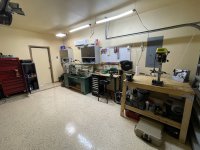Is your motor single phase? If I recall correctly some Grizzly lather owners have swapped their single phase motors out for three phase and had the vibrations reduce.
Chinese lathe spindles aren't very well balanced, and the chucks are usually pretty out of balance as well. I balanced my 3 jaw and it made a noticeable improvement. I didn't bother with the 4 jaw.
By far, the biggest improvement came when I swapped my chinese motor out with a Siemens 3 phase motor and a Teco VFD. It gave me a massive improvement in vibration, noise and surface finish. Especially in surface finish, and a big improvement in parting too.
The advantages dont stop there either.
With the motor control options the VFD has, acceleration and deceleration is very smooth and quiet.
I also installed a 4 way joystick jog switch for threading. On the joystick, left and right run the spindle forward/reverse @ 1/3 normal rpm. Down and up run it forward/reverse @ normal rpm. I set up the left/right low speed joystick jog functions to rapid stop using VFD braking.
Using the joystick In conjunction with VFD motor braking, , I can thread metric or inch, up to a shoulder without ever disengaging the half nut.
Left joystick takes a cutting pass, release the joystick stops the spindle instantly. Back the cross slide out a turn, then joystick up reverses the spindle at full speed, then feed the cross slide in a full turn, dial the next depth of cut on the compound and joystick left for the next pass. Repeat until finished.
The VFDs control inputs are wired through the lathes factory contactors, so all of the lathes factory controls and reversing lockouts work normally.
After using a 3 phase VFD setup, I'll never go back to a single phase motor. I like it so much that I swapped my mill over the same way. I put a joystick jog on it for tapping holes.
My custom cerakoted lathe panel

And the mill

The smoothness of power delivery from a 3 phase motor is vastly superior to that of a single phase.
While not completely or technically accurate, a decent analogy would be comparing a normal bicycle to a 3 seater bicycle. The normal bicycle gets power pulses 180 degrees apart, with each push of the pedals. So kinda a surge, surge, surge type power delivery, timed with the power companies 60hz AC frequency, with only one pedal, split by the motors run capacitor to serve as if it were two pedals.
A 3 seater has three sets of pedals, so power pulses are overlapping one another, resulting in much smoother power delivery. With a VFD, your also not limited the the power companies 60hz frequency.
The ability to vary the frequency let's you adjust the motor speed. Between the VFD and headstock gearing, I can go from 20rpm up to almost 3000.






